An L.C. Smith & Bros. No. 5 stayed at my place for a few days for some help. This SmithBro has been indulging in some hard living recently at Moe’s shop and needed an intervention.
At Moe’s, the carriage got jammed (inexplicably) way over to the right. I knew that if I left it that way, the typewriter might lose its balance and fall off a chair. I brought the SmithBro home to sober him up with black coffee and figure out what the heck was going on:
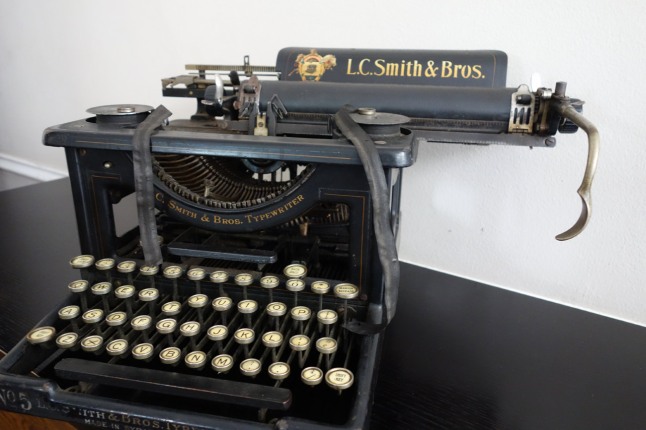
Your tie’s undone, Mister.
Huh.
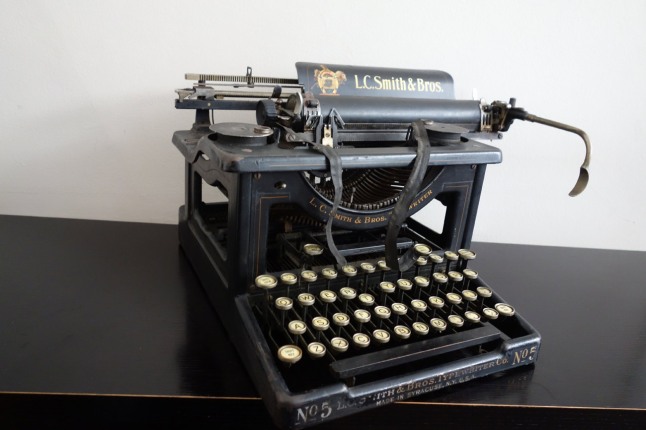
“Lady, I think I’m gonna be sick…”
I didn’t know where to start. I just could not get that carriage to move. For about an hour, I poked and prodded. I coaxed and cleaned. Nothing. I went to the internet. Fortunately, Knife141 had a similar problem. That guy. He. Has. Seen. Much.
Like Knife141’s typewriter, the problem seemed to come from the tab rack. I removed the two tab stops, wiggled the tab rack in back, pressed the tab bar in front and was finally able to move the carriage.
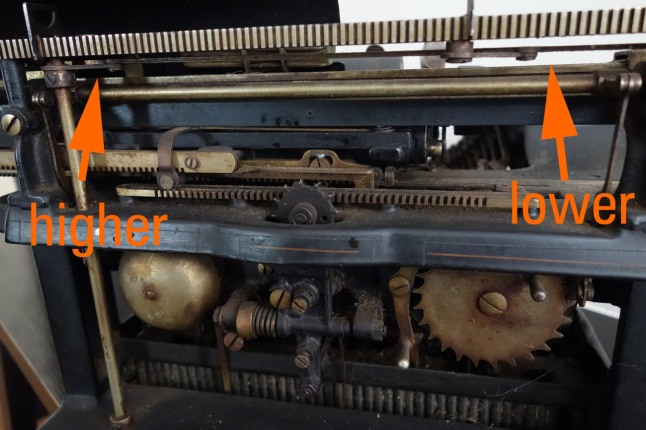
I am not quite sure what I did, but after that, the carriage moved freely – squeakily and crustily because of a very dirty carriage track – but freely. The tab mechanism under the tab rack was a little higher on one side than the other. It was possibly bent. Strategically-applied PB B’laster de-gummed the moving parts of the tab mechanism and the tabbing began to function.
How old is this thing? I found the serial number stamped inside the machine behind the tab bar: 192102-5

This is a 1912 typewriter per Typewriter Database.
This machine was pretty dirty. After an initial blow out out, I doused everything in mineral spirits. I’m starting to warm up to mineral spirits. I love denatured alcohol for cleaning, but it is so dangerous around painted surfaces. A stray drop of denatured alcohol will eat into paint quickly. Mineral spirits are a little more forgiving around paint.
The typewriter was typing great, even without a ribbon, but the platen was filthy:
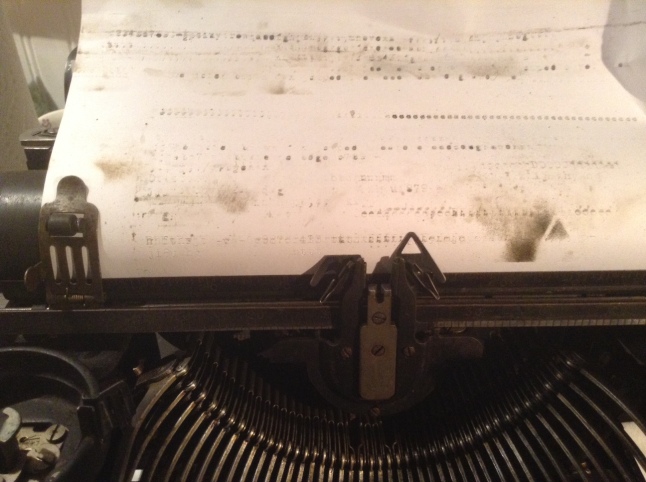
The platen on the old L.C. Smith standards pops out very easily. You loosen a couple screws on each end of the platen and slide the retainer back:
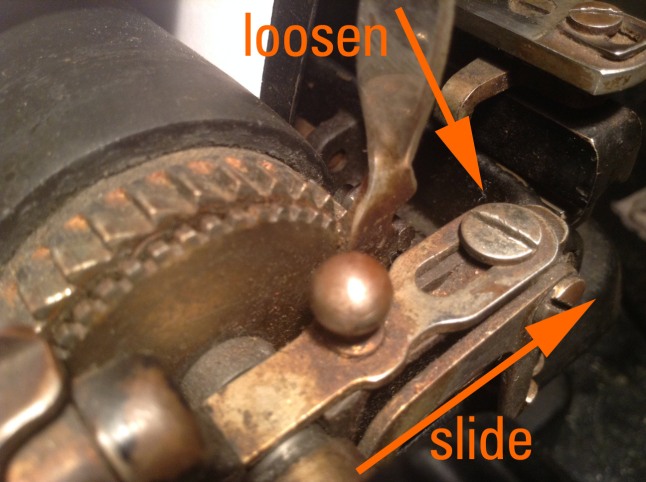
I popped the platen out and cleaned it with Soft Scrub:
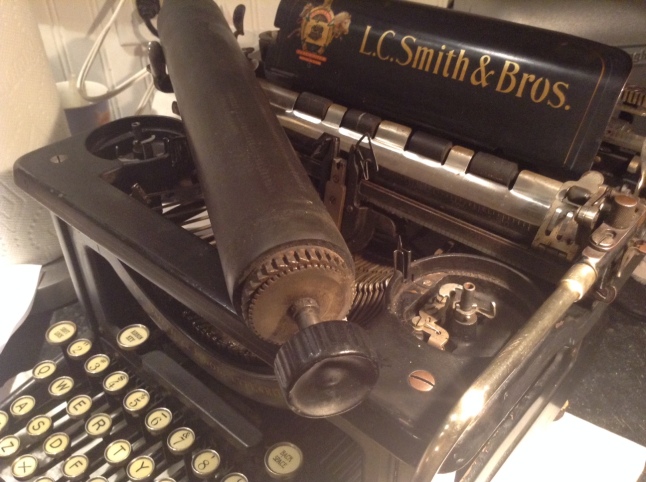
It is a 104 year old platen and it’s hard as a rock. Thwack thwack thwack – even with three sheets of paper.
It started me thinking: how much of the typing experience on an old typewriter has to do with the condition of the platen? I recently had a 100+ year old Underwood 5 stay with me, and it was a muted and delightful typing experience. It seemed to have a new-ish, soft-ish platen. The other 100 year old typewriters that I have experienced (Royal 10, LC Smith 8, Fox 24, Oliver 9, Century 10) have had rock-hard platens and been thwack-thwack-thwack experiences. They were springy and responsive typewriters, but very noisy.
Wow! That’s a handsome decal – it’s in such good shape:
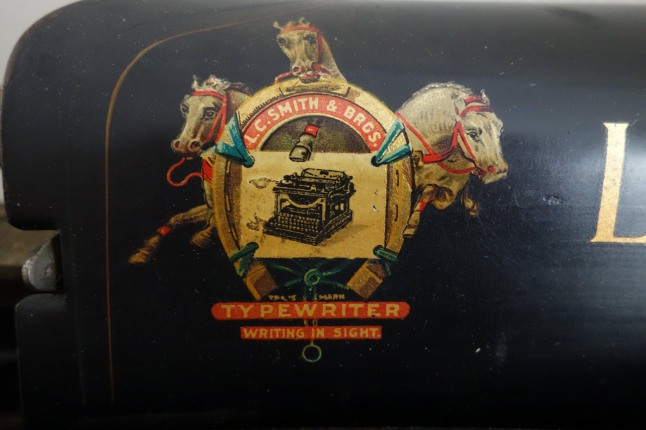
Magritte couldn’t have designed a better decal. Is that disembodied hoof trying to type – or destroy the typewriter? What does it all mean? Horsie the Destroyer.
The back space wasn’t working, so I investigated underneath the machine.
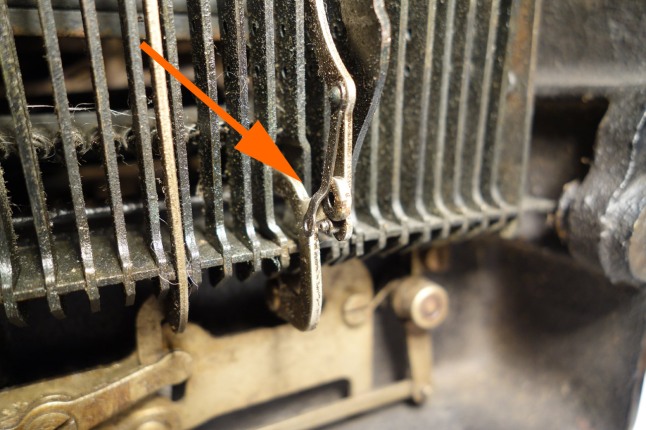
Clevis!!! Er – link spring. Old-timey clevis!! This is the technology that has been be-deviling me as I work on the 1960s SCM machines at The Shop at Flywheel Press. Snapped clevises (link springs) have be-deviled people for the past 100+ years.
Back space linkage is re-attached and all is well:
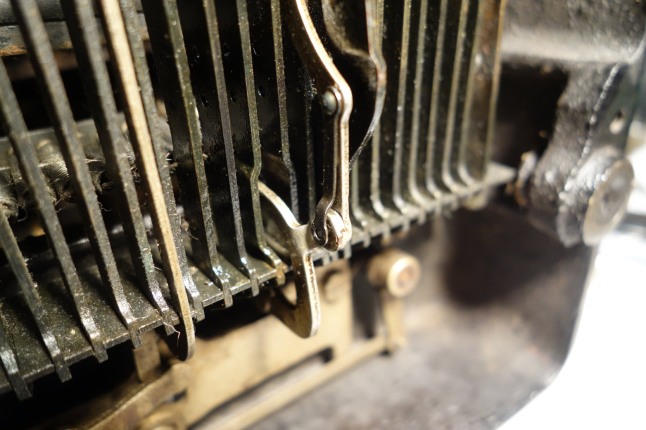
I scrubbed the grimy typebars with Scotch Brite and got the gumminess to recede with an application of mineral spirits. A couple letters were still not freely striking. As it turns out, their key levers were bent going into the comb that is the key lever guide. I had to straighten them out with pliers so they could move freely.
Baby needs a new pair of shoes
The feet were completely gone – just the remnants of old rubber in the hole. I made new feet out of cork:
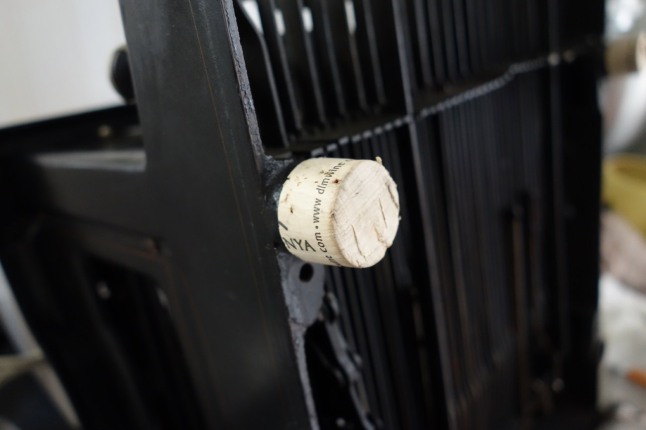
and colored them with Sharpie and India ink:

They look really good, but I want to get some rubber test tube stoppers as I think they will be more durable in the long run.
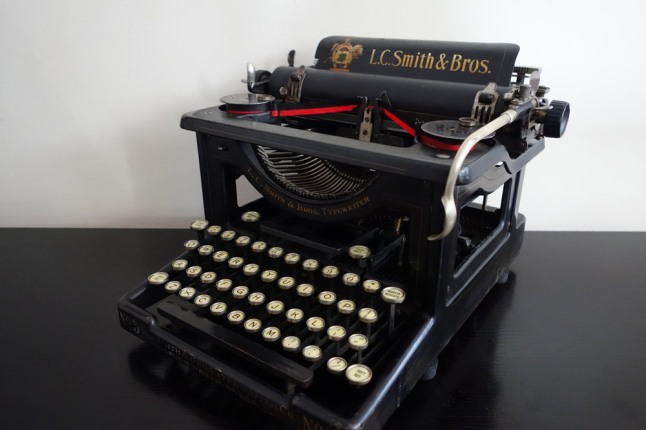
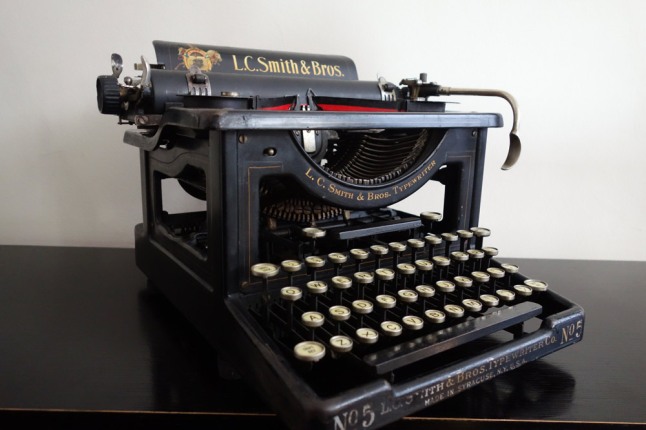
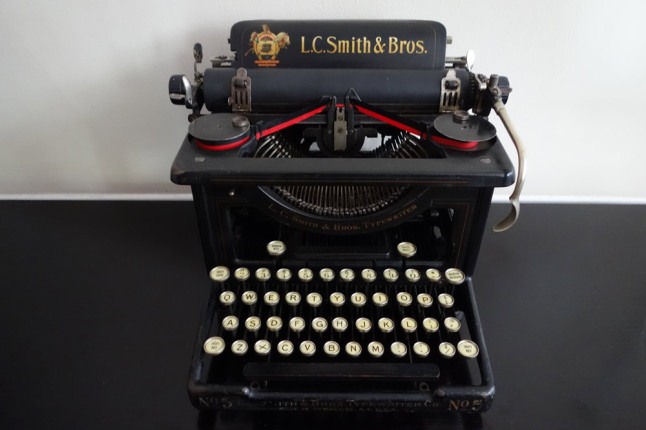

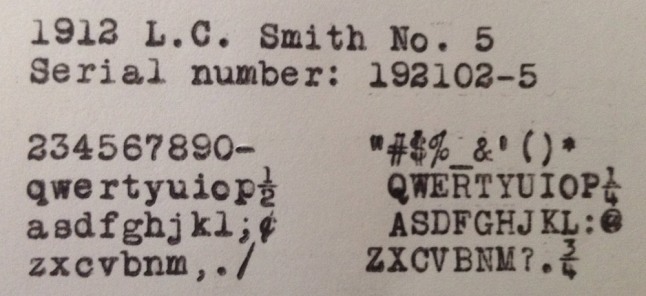
This SmithBro is so articulate! “QWERTYUIOP¼,” he said. So charming and well-spoken. And he is quite a handsome fellow now that’s he has showered and brushed his teeth. I should fix him up with my sister.
Nicely done! Yes, I agree that these older machine benefit greatly from fresh rubber. My U5, Monarch and Corona 4 have all had the platens recovered, and it really turns does more to make old iron delightful than just about any other improvement you can make. (:
Let’s hope Moe stashes the Smith in a place of secure honor as befits the old fellah, and not on some wobbly chair. 😀
LikeLike
I used to think that new platens were an extravagance – until I experienced the modern sound and feel of a hundred year old Underwood with a soft platen. I have an LC Smith No. 8 project typewriter that may end up with a new platen.
LikeLike
These LCSmith desktops are such elegant looking machines, and so fun to type on when in proper operational condition. And as this is the third one you have worked on, I must wonder if California is awash with them; I can’t find any up here in Idaho, so they must have all migrated to the warmer climate.
Regardless, another machine made beautiful again. Your patented technique certainly does on heck of a good job
LikeLike
The old timey LC Smith standards are soaking up the rays down here in California. This particular SmithBro is on his way to Taiwan. I brought him back to the shop and he was sold almost immediately to a Taiwanese collector.
There isn’t much to the M.O.T. Method of Typewriter Repair: it involves cleaning and re-attaching of detached parts. That’s about all I can do. Oh, and I am handy with duct tape and paper clips.
LikeLike
Very nice pictures and great service work! I do love the design of these LCSmiths (5&8) – it looks sort of like a beautiful and solid bridge.
Hey! You have a sister to fix up with someone and you only tell us now???!!! I’m interested! But on the other hand I’m not sure if I can compete with that LCSmith… 😉
LikeLike
Ha! Trust me Piotr, you’re better off sticking with typewriters. Members of my family tend to be “project machines”. 🙂
LikeLike
Another fine piece of work!
The tabulator links on LC Smiths are also held on with clevises, and also tend to get disconnected and disappear.
LikeLike
The first old LC Smith 8 that I worked on must have sat in a pool of water at some point in time because several of the delicate clevis-style tab linkages had rusted away to dust.
LikeLike
Love this! You consistently inspire me. I have one of these to work on out at the garage work bench when the weather warms and I have some free time. I learn so much from you! Love the feet you made.
My next foray into rubber-like material is a moldable glue that turns to flexible silicon. When I finally get that going, I will post my attempt and the result. It’s not a foot-making project, but if the material does what it claims it does, it may have potential.
There is no better onomatopoetic word for a type head striking a hardened platen than “thwack”. 🙂
LikeLike
Make sure you post about your experiences with the moldable glue – I am greatly interested.
LikeLiked by 1 person
Definitely will document the attempts. I have a specific, fiddly little bit I need to try to remake for a Consul portable that’s been neglected and abused. I thought maybe the moldable silicon glue could do it. Hope so!
LikeLike
I was pretty lucky to come across mine, a Smith&Bros. No. 5, in Buhl Idaho some years ago. I was re-creating some documents from the 1940s and was looking for a decent machine to work with. My mom was going to get me an electronic machine but a friend of hers had the No. 5 and gave it to me as a gift. As it turns out she was going to clip the keys for a friend to use in her art! I am truly happy I was able to get it before that happened!
Ive had her for over a decade now and shes in need of some work but she still types beautifully.
LikeLike
I am glad that you got the Smith&Bros No. 5 before its keys got clipped. I have a soft spot in my heart for those old ten-ton typers. Despite neglect and abuse, they are remarkably resilient and type beautifully despite many being well over a hundred years old.
LikeLike